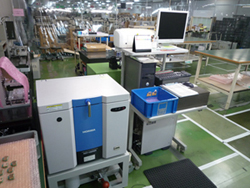HOME > Corporate Profile > Environmental Activities > Approach in Chemical Safety Management
Approach in Chemical Safety Management
Chemical Substance Handling Management
Many of RISO's products contain various chemicals, and the manufacturing process also requires such chemicals.
RISO requests each supplier to provide SDS* to verify the characteristics of each substance, including toxicity, handling precautions, storage and disposal methods, in order to ensure proper handling. Based on such investigation, RISO established specific standards to facilitate the safe use and storage of these chemicals.
Moreover, prevention of accidents and hazards is accomplished by educating the employees who handle, store or control chemicals, in addition to establishing applicable procedures. This achieves not only the safety and health of employees, but it also helps preserve the ambient environment.
*SDS (Material Safety Data Sheet)
A safety data sheet (SDS) is a form containing data regarding the properties of a particular substance, provided by the suppliers of such substances containing certain chemicals when they are sold or transferred to another party.
Cutting off PRTR Listed Substances
RISO is investigating the environmental release and transfer of toxic chemicals listed in PRTR*. Based on this investigation, RISO examines the possibility of reducing toxic releases, or switching to alternatives, so that total releases and transfers during the manufacturing process are minimized.
*PRTR (Pollutant Release and Transfer Register)
The PRTR is a system aimed at preventing environmental hazards through control of the corporations that deal with potentially harmful materials. The PRTR is an environmental database or inventory of potentially harmful releases into the air, water or soil. Also included in the database are wastes transferred for treatment and disposal from the site of their production. Corporations do this of their own accord, reviewing such data themselves, reporting to relevant administrative organs or publishing the information.
Conforming to Restriction of Hazardous Substances Directive (RoHS)
RISO established its "Riso Kagaku Group Green Procurement Standard", which specifies fifteen prohibited substances* and nine environment consideration substances.
*Including six substances restricted by EU RoHS Directive.
EU RoHS Directive
Restriction of Hazardous Substances Directive (RoHS Directive) took effect on 1 July 2006 by EU. This directive restricts the use of six hazardous materials in the manufacture of various types of electronic and electrical equipment. It restricts the use of Lead, Mercury, Cadmium, Hexavalent chromium, Polybrominated biphenyls and Polybrominated diphenyl ether.
China RoHS Directive
Restriction of Hazardous Substances Directive took effect on 1 March 2007 in China. Similar to RoHS in EU, six hazardous materials, Lead, Mercury, Cadmium, Hexavalent chromium, Polybrominated biphenyls and Polybrominated diphenyl ether, and materials fixed by the government, are restricted the use. There is a list of included products sold in China, known as the catalogue which is a subset of the total scope of Electronic Information Products, or EIPs, to which the regulations apply.
Vietnam Circular No.30/2011/TT-BCT
Tuyên bềEvềEsự phù hợp (hợp chuẩn, hợp quy) Các sản phẩm điện, điện tử của RISO tuân thủ theo yêu cầu của Quy định (Thông tư) N.30/2011/TT-BCT ra ngày 10 tháng 8 năm 2011 quy định giới hạn cho phép đối với một sềEchất độc hại trong các linh kiện điện, điện tử, có hiệu lực từ ngày 01 tháng 12 năm 2012
Riso electronic, electrical products comply with the requirements of Circular N. 30/2011/TT-BCT dated August 10, 2011 which temporarily regulates the permitted limits for some hazardous substances in electric and electronic, which come into effect on December 1st, 2012.
Complying with the RoHS (Restriction of the Use of Hazardous Substances) Directive

We survey legal and regulatory trends regarding environmental laws and regulations related to products in countries around the world. From the design and development stage, we use data on chemical substances used in parts, materials, ink, and others to comply with any restrictions on using hazardous substances.
